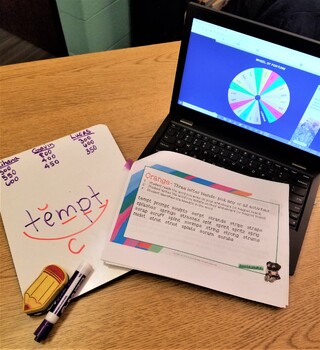If you’ve been teaching for more than five minutes, you already know one universal truth: kids learn better when they’re engaged. The trick, of course, is how on earth do we keep them engaged when the work is hard, repetitive, and not exactly what kids would describe as “fun”?
Enter: GAMES
I stumbled into this the hard way. I had a bright practicum student—smart as a whip, on the autism spectrum, and dyslexic. He would get frustrated when he made errors, and let’s be honest, Wilson lessons can feel long and heavy. One day he looked at me with that dreaded mix of boredom and desperation and basically begged, “Can’t we just play a game?”
Problem: when I started there weren’t any games that actually matched Wilson. Solution: I made one. I threw together my very first phonics UNO deck, we played, and… he was hooked. He wanted more. He was practicing without the groans. He even smiled. That’s when my “Fun Friday” routine was born—still structured, still aligned with what I was teaching, but wrapped up in cards, colors, and laughter.
It worked so well for him that I kept creating. And then my other students wanted in. And then my colleagues wanted to borrow them. Suddenly, I wasn’t just making one silly UNO game for one kid—I was making a toolbox of games that actually worked with Wilson and other highly structured literacy lessons. And here’s the part that might make you roll your eyes but is totally true: games really do work. Here’s why.
3 Reasons Games Work for Struggling Readers
- Repetition without resistance Struggling readers need a lot of practice. Like, more than feels fair. And let’s be real—telling a kid, “Okay, we’re going to read this word list for the fourth time today” is a recipe for eye rolls and fake bathroom breaks. But if the exact same words are tucked inside a Kaboom game? Suddenly, we’re on round 12 and nobody’s complaining. In fact, they’re begging to keep going because they want to “beat the game.” The skill is the same. The practice is the same. But the wrapper changes everything.
- Low-stakes risk-taking Mistakes feel very different in a game. If a student misreads a word during a one-on-one timed probe, you can practically see their shoulders tense up. But if they misread a card during Go Fish? They laugh, they retry, and we move on. That shift—where mistakes are part of the fun instead of something scary—means students are more willing to take risks. They’ll try words they normally shut down on. They’ll give it another go because the cost of being wrong is so low.
- More time on task Games stretch the clock in the best way. If kids are asking to play “just one more round,” you’ve won the lottery. More time engaged = more practice = more progress. And because they want to keep going, the quality of that time is better too.
The Friendly Pushback (Because I Love You, Teacher Friend)
Okay, here’s where I play colleague instead of cheerleader. Games are fantastic, but they aren’t a replacement for explicit instruction. (Don’t throw your coffee at me—I promise I’m saying this with love.)
Wilson is structured for a reason. If all we did was play games, we’d be entertaining kids but not necessarily closing gaps. Games are the sprinkles, not the cake. They’re the turbo boost after you’ve explicitly taught and modeled the skill.
So my two rules are:
- Teach first, then play. Kids need a clear model before they can practice in a game setting. And this works beautifully as a motivation tool. I may or may not have said one million times, “We can play a game if we get two lessons done this week.” Call it bribery, if you will, but it WORKS.
- Collect data, even if it’s messy. If you don’t track growth, it’s too easy to mistake “fun” for “progress.” I even collect data while they’re playing so not one minute is ever wasted.
Friendly honesty here: I’ve caught myself falling into the “just play the game, it’ll be fine” trap. (Usually on a Friday afternoon when my brain is cooked.) But every time I skip the teaching piece or forget to check for mastery, I pay for it later. Sure, the kids had fun, but the progress didn’t stick and the priority of completing a lesson didn’t either.
How-To Make a Game in 5 Minutes or Less
Here’s one way to dip your toes in without adding to your already Everest-sized to-do list:
- Pick one phonics target (like short a words or r-controlled vowels).
- Make a 20-card deck with those words. Use blank syllable cards, index cards, or scraps of paper. Easy peasy.
- Rule: “If you can’t read your card, you discard.” Add some fun! Steal your opponent’s missed card. Catch an error and have an extra turn, etc. Have your students come up with some rules, too.
- Play for 10–15 minutes.
Boom. You’ve just gamified your phonics practice, and your students will leave thinking they got away with something.
A Final Thought
Games are not fluff. They’re not “just for Fridays.” They are a powerful tool for helping struggling readers practice, take risks, and stay engaged long enough to actually get better.
But—and you knew this was coming—they only shine when they’re used alongside strong, explicit instruction. Think of them as the jelly to Wilson’s peanut butter. Both are fine on their own, but together? Magic.
So keep your core teaching strong, but don’t be afraid to sprinkle in the games. They just might be the reason your students finally stop groaning at word lists and start asking, “Can we play again?”
And hey, if you need me, I’ll be in the corner trying to figure out which of my five remotes actually turns the TV on. Spoiler: it’ll probably take me 12 minutes, three wrong inputs, and at least one accidental call to my mother-in-law. But once I finally get it right? You better believe I’ll keep pressing that same button forever. Because just like our kids, once I’ve practiced successfully (with a little bit of fun and patience), I’ve got it down. Now go make a difference in the world- one reader at a time!
Click here to check out all my great games!

